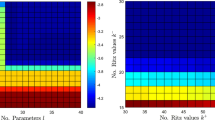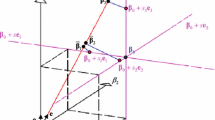Abstract
The paper is concerned with a class of structural optimization problems for which loading distribution and orientation are unspecified. The optimal loading conditions correspond to the extremal structural response, which can be used in assessment of structural safety or in generating the maximum structure stiffness or compliance. In identification problems the optimal load distribution is selected in order to minimize the distance norm between model prediction and experimental data. The sensitivity derivatives and optimality conditions are derived in the paper using discretized formulations. The generalized coaxiality conditions of loading and displacement or adjoint displacement vectors generate eigenvalue problems specifying stationary solutions. The paper is illustrated by examples of optimal loading distribution in structure design and identification.
Similar content being viewed by others
References
Åkesson, B.; Olhoff, N. 1988: Minimum stiffness of optimally located supports for maximum value of beam eigenfrequencies. J. Sound Vib.120, 457–463
Bojczuk, D.; Mróz, Z. 1998: On optimal design of supports in beam and frame structures. Struct. Optim.16, 47–57
Cherkaev, E.; Cherkaev, A. 1999a: Design versus loading: min-max approach, Proc. 3rdWCSMO, Buffalo, NY, pp. 51–53
Cherkaev, E.; Cherkaev, A. 1999b: Optimal design for uncertain loading conditions. In: Berdichevsky, V.; Jikov, V. (eds.) Homogenization. Papanicolaou: World Scientific, pp. 193–213
Cherkaev, A.; Kucuk, I. 1999: Optimal structures for various loading. Proc. 3rdWCSMO, Buffalo, NY, pp. 523–525
Dems, K.; Mróz, Z. 2001: Identification of damage in beam and plate structures using parameter-dependent frequency changes. Eng. Comput.18(1–2), 96–120
Haftka, R.T.; Scott, E.P.; Cruz, J.R. 1998: Optimization and experiments: a survey. Appl. Mech. Rev.51(7), 435–448
Gangadharan, S.N.; Nikolaidis, E.; Lee, K.; Haftka, R.T.; Burdisso, R. 1999: Antioptimization for comparison of alternative structural models and damage detection. AIAA J.37(7), 857–864
Garstecki, A.; Mróz, Z. 1987: Optimal design of supports of elastic structures subjected to loads and initial distortions. J. Struct. Mech.15, 47–68
Lee, J.; Haftka, R.T.; Griffin, O.H. Jr.; Watson, L.T.; Sensmeier, M.D. 1994: Detecting delaminations in a composite beam using anti-optimization. Struct. Optim.8, 93–100
Lekszycki, T.; Mróz, Z. 1983: On optimal support reaction in viscoelastic vibrating structures. J. Struct. Mech.11, 67–79
Lombardi, M.; Haftka, R.T. 1998: Anti-optimization technique for structural design under load uncertainties. Comput. Methods Appl. Mech. Eng.157(1–2), 19–31
Mróz, Z.; Rozvany, G.I.N. 1975: Optimal design of structures with variable support conditions. J. Optim. Theory Appl.15(1), 85–101
Mróz, Z.; Garstecki, A. 1976: Optimal design of structures with unspecified loading distribution. J. Optim. Theory Appl.20(3), 359–380
Mróz, Z. 1980: On optimal force action and reaction on structures. Solid Mech. Arch.5, 475–496
Mróz, Z.; Lekszycki, T. 1981: Optimal support reaction in elastic frame structures. Comput. Struct.14, 179–185
Mróz, Z.; Garstecki, A. 1997: Optimal loading in identification and design of structures. In: Gutkowski, W.; Mróz, Z. (eds.) Proc. 2nd WCSMO, Zakopane, IFTR, pp. 279–284
Olhoff, N.; Åkesson, B. 1991: Minimum stiffness of optimally located supports for minimum value of column buckling loads. J. Struct. Optim.3, 163–175
Rozvany, G.I.N.; Mróz, Z. 1975: Optimal design taking cost of joints into account. J. Eng. Mech. Div. Proc. ASCE101, 917–922
Rozvany, G.I.N.; Mróz, Z. 1977: Column design: optimization of support conditions and segmentation. J. Struct. Mech.5, 279–290
Szelag, D.; Mróz, Z. 1978: Optimal design of elastic beams with unspecified support conditions. ZAMM58, 501–510
Szelag, D.; Mróz, Z. 1979: Optimal design of vibrating beams with unspecified support reaction. Comp. Meth. Appl. Math. Eng.19, 333–349
Venter, G.; Haftka, R.T. 2000: Two-species genetic algorithm for design under worst case conditions. Evol. Optim.2(1), 1–19
Author information
Authors and Affiliations
Corresponding author
Rights and permissions
About this article
Cite this article
Mróz, Z., Garstecki, A. Optimal loading conditions in the design and identification of structures. Part 1: discrete formulation. Struct Multidisc Optim 29, 1–18 (2005). https://doi.org/10.1007/s00158-004-0474-0
Received:
Revised:
Published:
Issue Date:
DOI: https://doi.org/10.1007/s00158-004-0474-0




